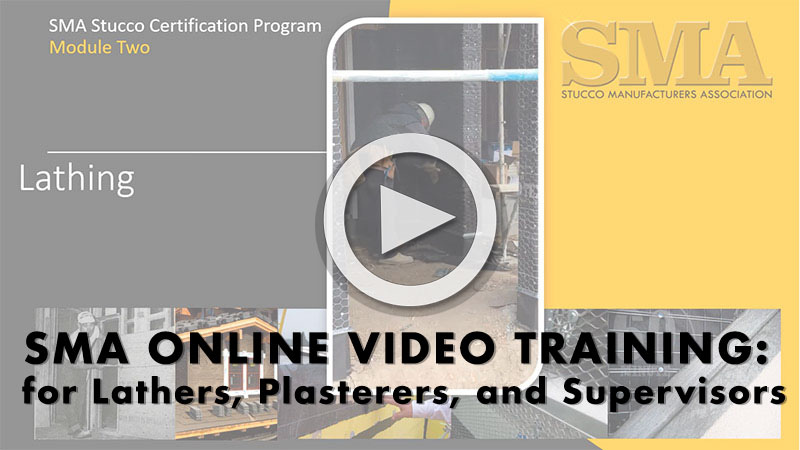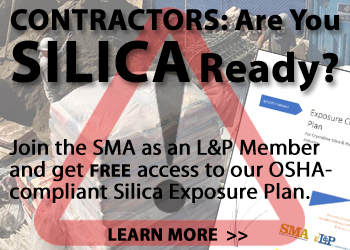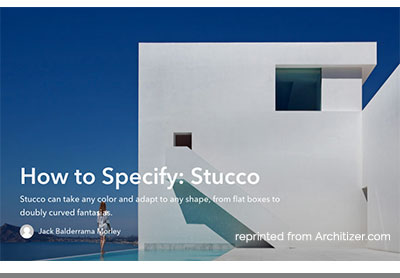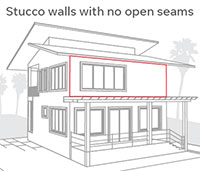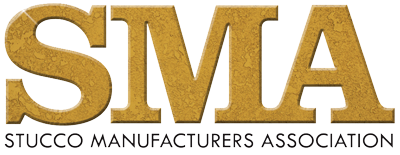Author: Mark Fowler
Summer 2024 eNews
In this addition you will meet the new SMA Board of Directors and read up on water resistant barriers.
Winter 2024 eNews
A lot is changing at the SMA and we are growing. A list of all the sponsors for the National Association of Home Builders ( NAHB) show is included and a brief write up on each of the sponsors. They not only financially support the SMA but work the SMA booth at this major trade show to promote stucco. Remember, developers and designers have cladding options, we want them to use stucco or EIFS.
Fall 2023 eNews
Summer 2023 eNews
SMA Membership Lunch Meeting
April 10, 2025 – October 10, 2024
6501 E Nohl Ranch Rd
 Map and Directions | Register Online Now
Map and Directions | Register Online Now
Description:
SPEAKER: Colin McCarthy , Attorney at Lanak and Hanna

TOPIC: Accord & Satisfaction
Construction is very transactional, and things change almost daily. Everyone deserves to get paid for services or goods rendered. Contractors and dealers have to make adjustments and can agree to accept a different amount of money, a form of payment or altered terms of payment. Most of these transactions go well. However, they can also go very wrong. There are laws that can help or hurt you, you need to be aware of the basic rules to protect yourself. Dealing with good people are never a problem, it is that person who knows how to play the game and then takes advantage of your good nature. DO NOT GET CAUGHT, GET PAID what you are owed. Come learn how to protect yourself.
Space is limited. Plan to attend and sign up now.
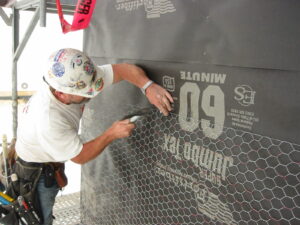
NEW MEETING LOCATION
Event Information:
- Anaheim Hills Golf Club
6501 E Nohl Ranch Rd
Anaheim Hills, CA
- 11:30 am: Registration & Networking
- 12 pm: Lunch & Program
- 48 hour cancellation required. No-Shows will be billed.
Members: $75
Non-members: $85
Winter 2023 eNews
The SMA’s Winter 2023 newsletter covers promotional efforts for the stucco industry at the NAHB Internal Builders Show.. We go in depth on cement plaster on masonry walls with a history , best practices, tips and options for making an outside corner. We include information about the upcoming Membership meeting on March 28 and information about our featured speaker. There is quiz on plastering and news of the passing of industry icon.
Fall 2022 eNews
The SMA has launched a new format and style of newsletter. We call it Tech Talk. This is because technical issues are a prime concern for all in the stucco industry. This issue focuses on windows in stucco clad walls. SMA provides some basic guidelines on flashing and what the code really says about flashing. Since we are a national association for lath and plaster, we will always try to cover the regional issues as well.
Spring 2022 eNews
FROM THE SMA EXECUTIVE DIRECTOR

Mark Fowler, SMA Executive Director
2022 SMA Board of Directors
The last few years have been tough, the SMA postponed board elections, stopped in-person meetings and canceled the annual golf tournament. The SMA is about to re-launch in-person meetings and working to making them virtual so out of state members can join in remotely. The SMA Board of Directors are from all over the United States: your current SMA Board is:
Dale Nehls, President, Quikrete
Kevin Wensel, Vice President, Omega Products
Tom Susko, Treasurer, Home Plaster Inc
Herman Guevara, Plastic Components
Dennis Deppner, Master Wall, Inc.
Gary Goodwin, K-Lath
Kevin Ordiales, Ashgrove Cement
DJ Farley, Weatherization Partners
Chip Blome, L&W Supply
The SMA board meets quarterly to discuss the industry and provide guidance to projects and direction taken by the SMA. This includes past accomplishments such as the only Silica exposure plan dedicated to plastering and adhered stone work with “Industry Objective “data on Action Levels and PEL. The six modules of on-line training for lath and plaster, including a supervisor’s class for plastering. The Stucco Market Study that uses US Census bureau data and ties it directly to the plastering industry. Tech Times Bulletins on recognized industry practices for lathing and plastering.
SMA HAPPENINGS NOW: The SMA routinely works with a variety of entities in the stucco industry and on occasion we get out to live events. The SMA recently was in Denver at Smalley and Co to do a training class on SMA Modules and certification. The even was well attended by local stucco contractors.
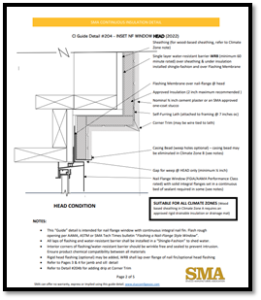
SMA UPCOMING: The SMA is working on a series of stucco details and a design guide. With three live webinars completed for Architects, the SMA has now become the leading source of information regarding lath and plaster product selection and design concerns. The request for details on stucco regarding Continuous Insulation, Rain Screen, over CMU and if the water-resistive barrier can be placed over the plastic insulation is immense. The SMA is responding with the largest library of details known in the industry. This includes tips, caveats and recommendations regarding Climate Zone. For example, Continuous Insulation Stucco for an Inset window (see graphic) is 6 pages covering an overview, head, jamb, sill, drip edge and options for stucco abutting the window frame. Details are reviewed by experts in building science, architecture and defect litigation. They are generic and considered “Guide” details to help designers create their own details that lath & plastering contractors will find constructable and cost effective.
CONTRACTOR ALERT
SMA Contractors – the new Silica Exposure Plan is available. All contractors are required by OSHA to have a Plan, perform air monitoring and have the Plan reviewed annually. The SMA does the air testing for various tasks (specific to lath/plastering and adhered masonry). You should print the plan and have that current plan available to workers, this can be inserted into your safety binder. The other requirement is to have an assigned Competent Person. The SMA provides a free on-line class for your Competent Person. There is a 25-question test to verify comprehension. A pictureID card can be issued upon passing the class upon request. There is also a tool box talk sheet that foreman can use to ensure you cover what OSHA requires be taught to your workers. The tool box form is also available in Spanish. Contact Marlene@Stuccomfgassoc.com
ASTM C1063
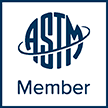
The SMA is frequently asked about ASTM changes to keep up to date with regard to installing lath and plaster. ASTM C 1063 is a nationally recognized standard used for the installation of lath for Portland cement plaster. It is a living standard that changes and evolves through committee action. Historically, the standard change very little. However, recently those changes have been more often and impactful.
The SMA is an organizational member of ASTM and compared the 2006 version to the 2020 version of C1063. The standards bare little resemblance to each other. The most notable changes are below. The next SMA newsletter will cover changes on C 926 (the application of cement plaster).
Most changes are related to shifting sections and edits or grammatical changes. Often new references need to be added to connect to related ASTMS. The SMA includes the section number for reference and a brief recap of the new language. SMA commentary is added if an explanation or caveat is advised.
The SMA provides this as a service to members, for exact language refer to ASTM C 1063-20.
2020 ASTM C1063-20
SUSPENDED CEILINGS: The older ASTM version had a large section on the rules for design and installation suspended cold rolled channels with various tables related to lath and plaster suspended ceilings. That language was removed and made as an ANNEX. It is still mandatory ASTM Language.
CONTROL/EXPANSION JOINTS: The most notable change related to these joints is adding a definition for each.
Section 3.2.2 now defines a control joint as a joint that accommodates movement of plaster shrinkage and curing along predetermined, usually straight lines.
Section 3.2.3 Expansion joints are defined as a joint that accommodates movement beyond plaster shrinkage and curing. There is now a NOTE or reference to design considerations shall see ASTM C926 A2.3.1.2. This C926 section states both control and expansion joints, including the integration with the water-resistive barrier shall be graphically depicted in the contract documents.
SMA Commentary: the SMA feels the new definition helps provide some guidance. In addition, adding the requirement to “graphically” depict joints on drawings (contract documents) will help contractors. The SMA agrees it is the architect who should decide where and how many control joints are needed. Including not requiring any control joints as they have the right per ASTM under “as specified” provisions. This is important as adding control joints after the plans have been approved by the city should be considered a legitimate change order item and not a design error by the designer or hidden cost assigned to the contractor. The SMA can help with this issue.
DELIVERY/STORAGE
Section 4.2.3 lath with factory paper backing shall be stored and handled to prevent puncturing the paper.
SMA Commentary: It has been reported that paper backing can be damaged during the delivery process. Suspicions are the paper-backed lath sheets may have vibrated resulting in damage to the WRB.
DESIGN/PRE-INSTALLATION: 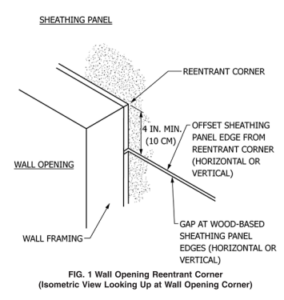
Section 6.1.1 framing member deflection shall not exceed L/360
Section 6.1.4 wood-based sheathing edges shall be offset a minimum of 4 inches from wall openings (see Fig 1) .
SMA Commentary: Many installers felt this was great news, the problem is if the stucco is removed and the joint is within 4 inches of the reentrant corner, you may be deemed in nonconformance to ASTM. Walk your project and at least notify the general contractor it may be an issue. Document that you pointed it out, particularly if they refuse to fix it.
Section 6.1.5 wood framing shall have a moisture content not to exceed 19% immediately before plastering
Section 7.2.4: damage to the WRB shall be made with the same or an alternative material compatible with the water resistive barrier before plastering.
Section 7.2.5: Z furring is now considered a customized furring system and shall be engineered.
TABLE 1– Flat rib lath is no longer permitted on unsheathed walls – Hi-rib is no longer permitted on all walls.
New ASTM – Refer to ASTM C 1861 for instructions on trim accessories
Section 7.3.2.4 Except for weep screeds, designated drainage screeds with solid flanges, the water-resistive barrier shall lap the flange of the accessory.
SMA Commentary: Short Flange casing has been used for several decades with no issues. The SMA agrees that “expanded” flange casing should not be covered, but short-flange casing, reveals and other may be covered, it is more of a design and intent issues. The SMA will stand with “alternates” on a case-by-case basis.
Section 7.3.5.2 Lath to concrete or masonry. Attachment is now prescribed as 16-inch OC as if the wall is framing with ¾ inch penetration.
SMA Commentary: The SMA still stands with one fastener per square foot is an acceptable practice.
SMA writes letters on a daily basis covering a variety of issues. Including code interpretation as well as ASTM interpretation. The SMA has been very successful with building departments when an interpretation on ASTM language is needed. EXAMPLE: Both old and new ASTM C1063 call for discontinuous lath behind a control joint. Continuous lath is routinely done and is a recognized industry practice by the SMA.
JOB PROBLEM OF THE MONTH
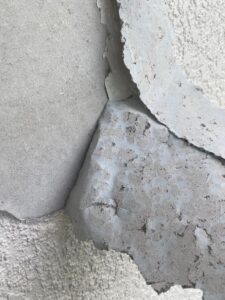
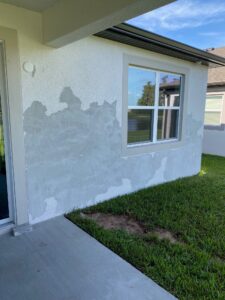
The SMA gets calls and emails from all over North America on stucco related concerns and troubles. With modern technology and camera phones, pictures can help make the story come to life. The goal of this new section to make contractors aware of issues and hope to help them avoid these issues themselves. There is no shortage of case files.
In Florida it is common and recognized to apply a lace texture to the brown coat and then paint as the final decoration. This homeowner could not understand why the paint was peeling off the stucco. While it could be considered a paint issue, the paint pulled off the stucco texture with it.
The SMA determined there were two issues
1. The cement texture was watered down to allow for workability, and possibly an additive. This resulted in a weaker than normal cement to cement bond.
2. The paint was applied only a few days later. The high alkalinity of the cement caused what is known as pH or alkalinity burn. This resulted in a breakdown in the binders used in paint. Paint should not be applied until the pH is near neutral (7)
NOTE: No weep screed was used because the plaster is over a solid masonry wall. This is code compliant and unrelated to the paint/stucco failure issue.
PLEASE NOTE: SMA OFFICE CONTACT INFORMATION
Mark Fowler, Executive Director
Marlene Lampert, Office Manager
Stucco Manufacturers Association
5753 E Santa Ana Cyn Rd, Suite G-156
Anaheim, CA 92807
Office: 714-473-9579
Mark@stuccomfgassoc.com
Marlene@stuccomfgassoc.com
REMEMBER: The SMA has a fairly large library on all things stucco. Members of the SMA are encouraged to call the SMA office if the staff can be of any assistance.
Fall 2021 eNews
FROM THE SMA EXECUTIVE DIRECTOR

Mark Fowler, SMA Executive Director
The Stucco Manufacturers Association (SMA) is working hard to promote stucco. Even with Covid keeping our in-person meetings to a minimum. The SMA has been doing a variety virtual meetings, classes and assistance to the architectural community. As codes and standards increase in complexity, they will need more and more help. The SMA is there for them. The SMA is a non-profit association representing the industry as a whole, not a single manufacturer, not a specific system or contractor, but all the industry. This makes the SMA a little unique and gives us influence. The SMA does not turn down or charge a fee to anyone calling in for assistance. Architects, general contractors and building owners look at the SMA as a kind of Consumer Reports group on steroids. The SMA also works hard to make sure members products and services are listed and referenced in project specifications. The SMA will recommend specific products when a perfect fit is noted or asked if there is a recommendation, this happens a lot.
Many designers are finding the SMA Contractor certification program particularly useful. Only a state license with the lowest bid is not much assurance the contractor is qualified to do the work. The SMA now has certified contractors in four states and expanding. Recently we even had an inquiry from England. The reviews of the six modules of training are overwhelmingly positive. The most impactful and relevant comments come from installers ( lathers and plasterers) who say they learned something new. If you have not checked out the modules yet, they are free, yes free to everyone to watch (online training program). The SMA felt it was important to make an effort to standardize industry practices, yet still allow for regional preferences. The goal is to make this a wide spread program that is nationally recognized and there is a powerful reason why. The SMA recently sat with one of the overall Insurance industries board of directors and she thought our program was great and compared it to the national roofing industry program, those contractors enjoy reduced premiums as the insurance industry feels more confident in their work. However, that group is more wide-spread as compared to us as we are just getting started. The insurance industry is looking to us to hopefully make a difference. Promoting the SMA certification program is a step to reduced risk for them and lower insurance premiums for you. What is the cost of certification? It is essentially free to SMA members. The future is in your hands, it is your industry and action or inaction will direct us all. (How to become Certified)
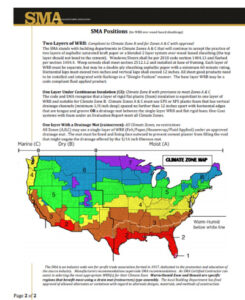 INDUSTRY NEWS
INDUSTRY NEWS
New 2021 code- the new International codes have significant changes when cement plaster is applied over wood-based sheathing. For the first time the codes mandate variations in application and design with regard to Climate Zones. The climate zones would technically be more appropriately called “moisture” zones. There are three of these zones for the United States A (moist), B (dry) or C (marine). The SMA has been giving classes to installers and even building departments on this new change. You maybe thinking “I have not seen this on my project, how can this be true?” The code cycle is every three years and the international codes come out first with state and local codes following in the next few years. So, get ready, it is coming as it has been written and published, just yet to be enforced. If you have not downloaded the SMA Tech Times bulletin on this topic, consider doing this soon, at least before the code hits you in the face. A word of caution, in litigation ignorance of the law, particularly when it is very industry specific, is not typically a viable defense. Be informed, be prepared.
MARKET NEWS
EAST vs WEST
While drywall is used with great regularity around the United States, stucco is only popular in some pockets or regions. Many believe that stucco is only suitable for warm dry climates. This explains why stucco is so popular in Southern California, Texas and Florida. Yet, it is hard to imagine Florida as dry. It maybe more accurate to state some believe stucco is NOT suitable for snow regions of the country. Due to freeze thaw concerns. However, the Swiss and Germans have used and continue to use cement stucco all the time. The truth is stucco works in all climates. High moisture areas simply require a little more attention to flashings, cold or snow regions require thinking of snow drifts, but it is not difficult to make stucco work anywhere.
The southern sections of east and the west coast are both popular stucco markets. With contractors’ members in all regions, the SMA must be adaptable to each region. The sad truth is that many experts in a region feel their way is the “only” way to install lath and plaster. This is what makes the ASTM committees a hot bed of in-fighting. They rarely agree on anything and seem unwilling to capitulate the other side has a proven regional practice. This explains why many contractors on both coasts routinely turn to the SMA for help with clarification on standards and allowed industry practices. Some feel we need a single inflexible standard with no allowances for regional practices, but how could that possibly work? Adding to the fact the international code has now set a precedent of regional practices by implementing the three climate zones with very different installation practices, it seems impossible. Whether we like it or not, there are regional practices and preferences. Most on the east coast refuse to use woven wire lath and that is fine. But the SMA will not state it is illegal. Here are some generalities about each coast of the USA regarding stucco.
WEST COAST: Pumping cement plaster is king in the west. The crews have mastered the art of machine application and the result is lower installed costs on basic residential tract work. It is so low, that vinyl siding has a hard time competing against stucco. This in turn allows custom homes to look at smooth trowel plaster. The added cost of the base and mesh to reduce cracks have made smooth trowel plaster the once hated finish to a preferred and affordable finish in the high end markets. One coat stucco is also gaining popularity , mostly in the residential market due to the Tongue and Groove insulation providing continuous insulation. More good news, these systems have been tested and meet the more stringent code requirements for enhanced drainage for Climate Zones A and C. Commercial work is primarily three coat stucco for durability and the inherent fire ratings in the code. While there are slight changes on the west coast from south to north, installations are similar. Stucco is just less popular as you move further north up the coast. Ironically, the use of the plaster pumps is also less popular moving up north and can impact installed costs.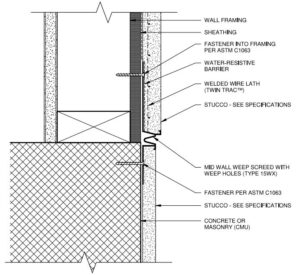
EAST COAST: The similarity for the east coast is the stucco market shrinks moving north, but does not seem to be related as much to machine production rates as other factors. Florida is the big market in the east. Unlike California, there is a major difference in application from south to north. In the southern part of the state, walls are mostly Concrete or CMU. The plaster becomes a parge coat and a finish may or may not be applied. Most stucco is painted. Elastomeric coatings are fairly popular. The vapor drive is opposite of the rest of the country, so that may be the better method of installation in that region. Moving north in Florida, projects start to see stucco on framing. It is also common to have the first floor CMU and the second-floor wood framing. This resulted in a massive number of leaks as the designers and installers failed to install a functioning weep device at the transitional floor line. That has been rectified and it is now common to use the PVC mid-wall weep screed as pictured. Both Plastic Components and Clark Dietrich manufacturer these products. They both have proven effective to stop the leaks.
TECHNICAL CORNER
COLD WEATHER PLASTERING
Cold weather is approaching. In parts of Canada, tenting the work is common practice. In really cold areas, they wait until Spring. It is true that freezing cement is a potential issue and should be avoided. Freezing stops the hydration process. This means the cement plaster does not get hard. The fear of freezing cement so great that manufacturers and ASTM prescribe that plaster should not be applied in temperatures below 40 degrees F. The SMA has experience in cold weather plastering with projects in Alaska, Minnesota and more moderate cities like Seattle. Many regions get cold, really cold and plastering should stop. However, much of the country is like Seattle. A kind of mix of sleet and frost. A Seattle pattern can be just below 40 F in the night and over 50F during the day. This is not an issue for Portland cement plaster. Cement plaster does not freeze easily. The temperature would have to be below freezing for at least a few hours for the cement to freeze. Even if it did, it can often be brought back the next day with minimal damp curing when temperatures climb above 40F. This also does not impact the cement plasters service life or its fire rating.
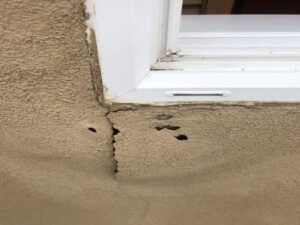
Acrylic finish coats are another story. They must be allowed to dry. Cement sets as it cures, we tend to say acrylics dry to a cure. While not technically accurate, it is better thinking this way. In addition, the acrylic dries from the outside in, as opposed to cement that cures from the inside out. What can happen is the acrylic gives what is called a “false set” on the surface. It may feel hard and cured, but is still soft against the cement plaster basecoat. If temporary protection protecting the acrylic finish is removed to soon, the set (cure) will never take place. The first rain or water can create bubbles or wash the acrylic off the basecoat. See picture . This is why plasterers in regions with temperatures than dip near freezing are very careful about using acrylic finishes in cold weather.
SMA BOARD OF DIRECTORS 2021
At the most recent SMA board of Directors meeting , Rick Durham was selected to be President of the SMA. Rick is from Texas and has a long history in the plastering industry. He was a plasterer and is a valuable resource to many of the contractors in his region. Rick has served on the board for the Texas Lath and Plastering Contractors Assoc (TLPCA) . as well as the National One-Coat Stucco Assoc (NOCSA). Currently Rick is running EZ Wall Concentrate, a producer of quality bagged cement products including basecoat stucco and tolling operations. Rick Durham believes in stucco and hopes to unite our efforts to preserve and grow the stucco market. He focuses on market share for our industry and limiting risks that plastering contractors face. His expertise and leadership will be helpful to guide the SMA into this new decade. Your SMA board of Directors:
Rick Durham- President (Texas)
Kevin Wensel-Vice President (California)
Justin Fleming- Treasurer (Florida)
Thom Susko – (California)
Herman Guevarra – (Florida)
Gary Goodwin – (Arizona)
DJ Farley – (California)
Dale Nehls – (Colorado)
NEWEST SMA CERTIFIED CONTRACTORS
Orlin’s Stucco – Florida 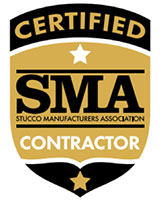
Prime Wall Systems – Texas
Onyx Group – California
Ronparco -Texas
SMV Stucco – Florida
HPS llc – California
Not Certified? It has benefits, strengthens our industry and works to lowering risk and reduced insurance premiums.
Get certified for the industry and yourself.
Please feel free to call the SMA office if we can be of any help.
Respectfully,
Mark Fowler , Executive Director
PLEASE NOTE: SMA OFFICE CONTACT INFORMATION
Mark Fowler, Executive Director
Marlene Lampert, Office Administrator
Stucco Manufacturers Association
5753 E Santa Ana Cyn Rd, Suite G-156
Anaheim, CA 92807
Office: 714-473-9579
Mark@stuccomfgassoc.com
Marlene@stuccomfgassoc.com
REMEMBER: The SMA has a fairly large library on all things stucco. Members of the SMA are encouraged to call the SMA office if the staff can be of any assistance.
Spring 2021 eNews
FROM THE SMA EXECUTIVE DIRECTOR

Mark Fowler, SMA Executive Director
STUCCO LIVE! is back. The World of Concrete convention will be held June 8-10, 2021, at the Las Vegas Convention Center. As with previous years, the SMA will partner with the OPCMIA to put on live presentations of cement plaster applications. A focus will be on the new International Building Codes requirement regarding water-resistive barriers when using cement plaster. Please read Been Doing This for 30 Years (see below) to learn more.
STUCCO LIVE! has been moved to the North Hall, next to event registration. We hope you can swing by and say hello. There will also be live classroom education this year by the SMA on the lathing and plastering modules of our Stucco Training Course. Attendees to the class will qualify to take tests for the online training cards and start the certification process. Each class is 90 minutes long and suitable for novices and experts in the plastering industry.
“Been Doing This for 30 Years”
Many of our contractor members are old pros. Your experience and knowledge is invaluable, and far be it for the SMA to tell you how to do stucco. Stucco has been around a long time and, while the codes have changed, stucco has not. What you did when you were young probably still works. Even if dragged into court, your old ways can be defended, and the SMA stands with you on these tried-and-true practices.
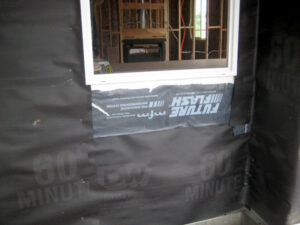
However, 2021 is a change – a big change for stucco. Old-timers have been putting on two layers of black paper over wood-based sheathing for decades. We did it before it became part of the building code in 1982. Even with recent tweaks to the code, it was still business as usual. NOT ANYMORE.
Section 2510.6 of the 2021 International Building Code has changed all the rules. The International Residential Code has followed suit with highly similar language.

This new code language will likely put stucco at a disadvantage compared to other competitive claddings in the fight for cladding market share. Besides a likely loss of market share, the new code is confusing, and the SMA office has been contacted and asked many times for clarification. SMA contractors may have already seen the language and are likely scratching their heads. You are not alone: everyone is confused.
SMA Virtual Membership Meeting: May 12
Our SMA Member Meeting – on May 12th at 11:00 am (Pacific time) – will present our SMA Technical Paper written to cover the new IBC information and provide clarification and some guidance.
We know you have questions. Are two layers of asphaltic paper still allowed? What does Climate Zone A, B, or C mean? The reality is there are experts out there just looking to play gotcha. They want to tear into your stucco and say to the owner, “Code Violation.” This can impact designers as well. We have all seen outdated specifications, with products listed and manufacturers long out of business. It is not hard to imagine two layers Grade D being used and a consultant rubbing their hands together, thinking it is now payday for them. There are still some options left to us, just not as many as before.
The SMA will cover these options in our virtual SMA membership meeting on May 12 as we introduce our newest technical paper intended to educate and help you protect yourself. [Register in advance for this meeting. After registering, you will receive a confirmation email containing information about joining the meeting.] REGISTER NOW—>>
Silica & OSHA
The news on silica is that the OSHA has directed all regional OSHA offices a National Emphasis Program (NEP) that directs them to identify and reduce worker exposures to respirable crystalline silica (RCS) in general industry, maritime and construction. The NEP targets specific sectors expected to have the highest exposures to RCS.
As a directive from national to all regional offices, it will be taken seriously – so should all SMA employers. Verify your written exposure plan is up to date: the SMA has the new plan ready, and it is free to members. SMA also offers competent person training as part of our online Stucco Training Program that can be viewed at your supervisor’s convenience.
The rule also requires you to train or “educate” your workers on silica exposure. The SMA has a free eight-minute video to cover the very basics for workers. There is a five-question quiz. Silica dust is not a joke; neither is being fined. Protect yourself.
We also offer a Toolbox Talk sheet for the foreman which has all the topics listed that OSHA employers must convey to workers regarding silica exposure.
Make sure you are part of the SMA Silica Exposure Program and listed on the SMA website as a member. This allows you to verify to others your firm is part of the program from your smartphone. Protect yourself – it is free and easy to do as an SMA member.
TRADE TIP: Floating the Basecoat
Lath and plastering are skill-intensive trades. However, it is often overlooked that they are also knowledge-based. Knowledge can come from experiences, classrooms, or mentoring. Experiences, particularly the hard lessons of failures, are the worst and most painful method. Classroom education is excellent but sometimes better suited for trades like electricians or HVAC workers. Lath and plastering have traditionally relied on mentoring. This is when the old craftsmen teach the young the how and, most importantly, the why. Mentorship works but requires mentors and willing students. Both seem to be in short supply for the industry.
The SMA will now start a section in each newsletter called the Trade Tip. This will be a tip in the trade of lathing or plastering that old mentors would have typically passed along to those entering the craft.
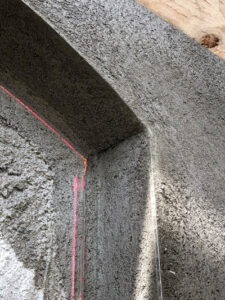
This Tip deals with what the industry calls “hard floating” the membrane. Floating the brown or basecoat is meant to clean edges, terminations and prepare it for the finish coat. But floating is more than that. Floating the cement plaster should also consolidate and densify the cement plaster membrane. A properly densified ¾ inch cement membrane is more resistant to cracks and water penetration. This is not theory but fact. If this is not enough to convince nonbelievers, it is required by ASTM C-926-19 Section 7.4.2.2 “… floated uniformly to promote densification of the coat… .” Timing and tool selection are critical to float the cement plaster properly.
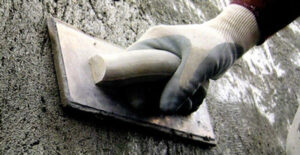
A hard float is one with wood, cork or neoprene material. A green, tan or red sponge is not a hard float. Floating is best done when the plaster has lost the excess mix water needed to apply the cement plaster, but before it starts to set. There is a window of opportunity for timing. A tip on timing is to push the hard-float to the wall. When it does not stick, the wall is ready to float. What must not occur is to have the cement membrane move under the pressure of float. Another image to consider is a ¾ inch raw steak. Pushing on it moves the mass as it shifts under pressure. When the excess moisture has evaporated, the shifting stops and densification can be achieved. The pressure applied to the float only has to be moderate to achieve proper densification.
Plastering is not the only industry that relies on the densification of a cement membrane to achieve a sound membrane. The cement terrazzo flooring industry has a similar practice. They pour up to two inches of pigmented cement with marble chips and no sand. They patiently wait until excess mix water begins to evaporate, and then they start to roll the terrazzo with a large, heavy roller. The act of rolling densifies and compacts the cement. Without the rolling of the cement, they would have excessive cracking and a weak terrazzo floor. They keep this practice alive by good mentoring. They know this is what leads to a long-lasting, crack- and water-resistant floor. Like plastering, ignoring a critical part of the operation can lead to problems.
The Insurance Blues

The SMA is aware our good plastering contractors see increases in liability premiums. Rates are climbing fast and high, even for those with a flawless track record concerning claims. We know many contractors see these insurance premiums impacting their bids and making it tougher to compete with other claddings.
If you think this is an accident or coincidence, it is not. Groups are trying to take the stucco market, and increased premiums coupled with fear to designers is a proven tactic. Think of what the EIFS industry went through.
We have heard you and are trying to do something about it. The SMA has been busy building a bridge with the insurance industry. The insurance industry has a research center in South Carolina where they fund testing roofs, concrete, walls, and other systems. The result is new codes, insurance policy procedures as well as policy exclusions. It is hard to understate the importance for the plastering industry to be working with them.
The SMA has offered a helping hand in the development of various walls to be tested. They appreciate the help and eventually told SMA they would work to get SMA on the committee overseeing building envelopes related to insurance issues. As far as we know, no one from the plastering industry has ever gotten this far with the insurance industry. It may be our chance to not only be heard but play a role in what happens in the future to your insurance policies and premiums.
SMA trips to South Carolina will be a strain on the SMA budget and resources. Mergers of corporate giants have impacted the revenues of the SMA’s future. In short, SMA needs our members’ help, particularly the contractors. First, you have the most skin in the game, and you have the power to make SMA a stronger voice in the industry. The SMA does not need more money from you – instead, SMA requires more suppliers and manufacturers to join our collective fight for our industry.
How can you help? Tell your material suppliers and manufacturers to join the industry and support our collaborative efforts. We can, working together, help lower insurance costs, protect contractors at the code level and make stucco a stronger market and a better market. We are all fighting for the same thing and, as their customer, they will listen to you. If they reply, “we are SMA members,” thank them for their support. If they ask “why should we join?” tell them we are ALL trying to protect our collective market. Join us and be part of the solution. The SMA believes, all together, we could be a strong and influential voice to the insurance industry.
SMA Contractor Certification
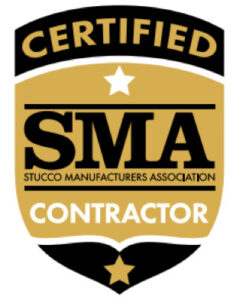 Congratulations to the latest batch of SMA Certified Contractors. They have taken the required training classes, passed the testing, and cleared with references to verify they’re part of a higher group. Architects are starting to add SMA certifications to their project specifications in South Carolina, Louisiana, Colorado, Illinois and California. The SMA board of directors approved these certifications at the last board meeting.
Congratulations to the latest batch of SMA Certified Contractors. They have taken the required training classes, passed the testing, and cleared with references to verify they’re part of a higher group. Architects are starting to add SMA certifications to their project specifications in South Carolina, Louisiana, Colorado, Illinois and California. The SMA board of directors approved these certifications at the last board meeting.
Prime Wall Systems
LLC Hutto, Texas
Onyx Building Group
El Cajon, California
SMV Stucco Inc.
Orlando, Florida
Ronparco
Euless, Texas
HPS (Home Plaster Shop) Inc.
San Clemente, California
PLEASE NOTE: SMA OFFICE CONTACT INFORMATION
Mark Fowler, Executive Director
Marlene Lampert, Office Manager
Stucco Manufacturers Association
5753 E Santa Ana Cyn Rd, Suite G-156
Anaheim, CA 92807
Office: 714-473-9579
Mark@stuccomfgassoc.com
Marlene@stuccomfgassoc.com
REMEMBER: The SMA has a fairly large library on all things stucco. Members of the SMA are encouraged to call the SMA office if the staff can be of any assistance.

